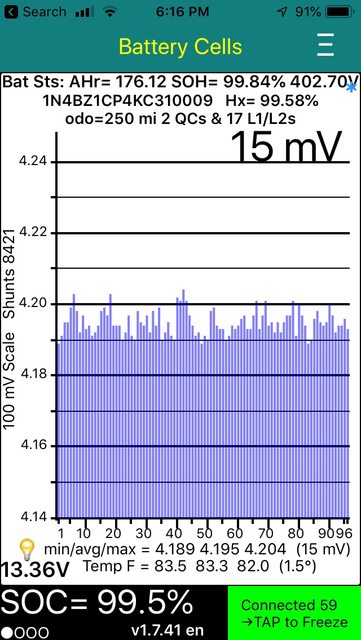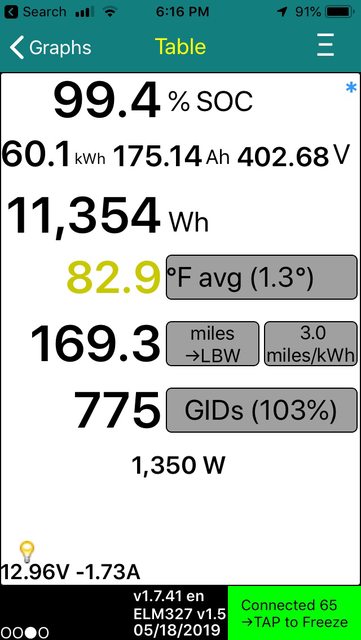oz10k
Active member
What is the maximum (new car) AHr value from Leaf Spy for each battery size:
24 kWh
30 kWh
40 kWh
62 kWh
Thanks,
Ron
24 kWh
30 kWh
40 kWh
62 kWh
Thanks,
Ron



LeafG said:Why did you say 167.6 for a 62kwh leaf when above everyone says 176.12? Can no one actually answer this questions clearly??
Not necessarily true. In my case, the initial Leaf Spy AHr reading was 175.15 at 64 miles on odometer and reading was 167.69 at 19,662 miles after 12 months of use. Readings after the last full charge were 165.36 AHr at 26,187 miles after more than 17 months of use.DougWantsALeaf said:For the first 3 months you get access to 60kWh, then the bms pulls access away for 5-7% over next 3-12 months. It is an open debate as to whether or how much capacity the bms is hiding.
That is wild speculation, unless it is backed up by cell voltage readings at full charge.DougWantsALeaf said:For the first 3 months you get access to 60kWh, then the bms pulls access away for 5-7% over next 3-12 months. It is an open debate as to whether or how much capacity the bms is hiding.
Since the voltage varies between discharged and fully charged, the service manual uses 360 for the nominal voltage. If you divide the published capacity by 360, the results are close to the AHr reported by Leaf Spy for a new battery. In my cases 62,000 Wh/360 V=172.22 AHr and 24,000 Wh/360 V=66.67 AHr are close to what Leaf Spy reported when the batteries were new.alozzy said:Does anyone know why the Ah, as reported by LeafSpy, seems to be higher than expected (based on the kWh capacity)?
alozzy said:Agreed, that math works...
So, I think you are saying that the nominal capacity, at 360V, is 62 kWh. If that's the case, then a fully charged pack has a capacity of:
172.22 Ah * 402.68V = 69.3.kWh
Correct?
Now that's a fact! My LiFePO4 12v battery sits ~13.2v.LeftieBiker said:You might just as well ask why "12 volt batteries" are rated that way, when they are more like "13 volt" batteries.
It's not a matter of voltage sag under load, the battery really does drop in voltage as it is discharged. It is a reflection of ion migration.alozzy said:As a load (LEAF motor) is placed on the battery pack, current flows and the voltage drops, but this is true at any state of charge whenever a load exists...
So, isn't the nominal 360V state just as arbitrary as using 100% SOC? Surely the capacity of the pack at 100% SOC is what's most important?
I'm not trying to be difficult, just trying to understand how the "useable" kWh of the pack is actually determined from a "real world" perspective...
Enter your email address to join: